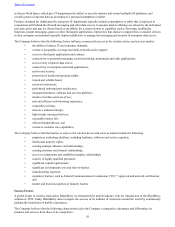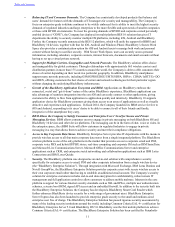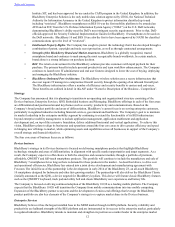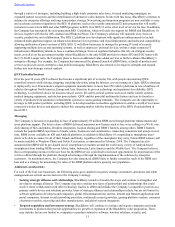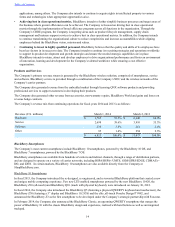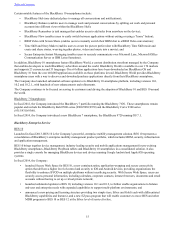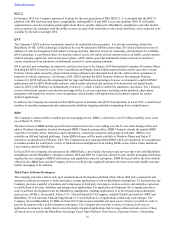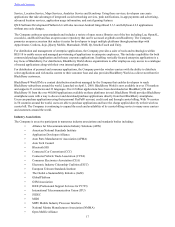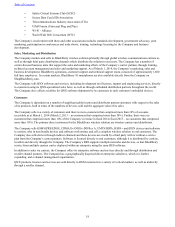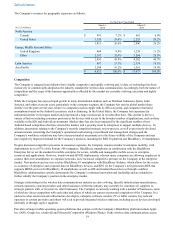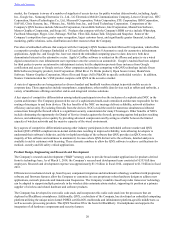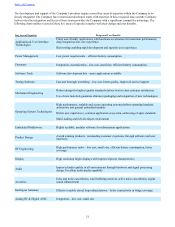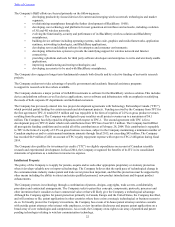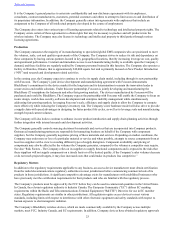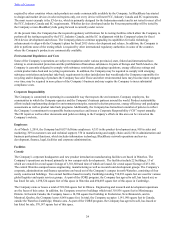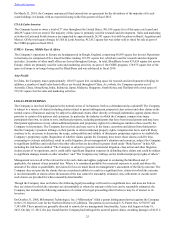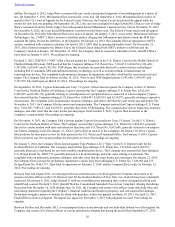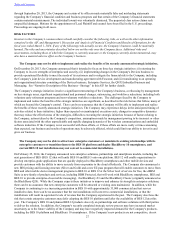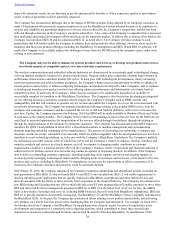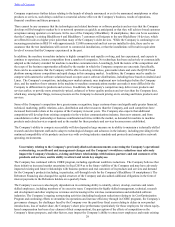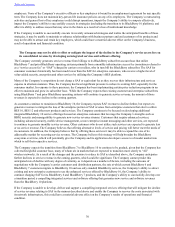Blackberry 2014 Annual Report Download - page 28
Download and view the complete annual report
Please find page 28 of the 2014 Blackberry annual report below. You can navigate through the pages in the report by either clicking on the pages listed below, or by using the keyword search tool below to find specific information within the annual report.
20
market, the Company is aware of a number of suppliers of access devices for public wireless data networks, including: Apple
Inc., Google Inc., Samsung Electronics Co., Ltd., LG Electronics Mobile Communications Company, Lenovo Group Ltd., HTC
Corporation, Huawei Technologies Co., Ltd., Microsoft Corporation, Nokia Corporation, ZTE Corporation, IBM Corporation,
SAP AG, Citrix Systems, Inc., VMware, Inc., Mobile Iron, Inc., and Good Technology Corporation. Competitors of the
Company's QNX business include Microsoft Corporation, Green Hills Software, Intel Corporation, MontaVista Software,
Mentor Graphics Corporation, and Sysgo AG. Products that compete with the Company's BBM service include WhatsApp,
Facebook Messenger, Skype, Line, iMessage, WeChat, Viber, Kik, Kakao Talk, Telegram and Snapchat. Some of the
Company’s competitors have greater name recognition, larger customer bases, and significantly greater financial, technical,
marketing, public relations, sales, distribution and other resources than the Company.
Providers of embedded software that compete with the Company's QNX business include Microsoft Corporation, which offers
a competitive product (Compact Embedded or CE) and offers the Windows 8 Automotive stack for automotive infotainment
applications. Apple Inc. and Google Inc. have not entered the embedded computing space to date; however, both have
demonstrated interest in the automotive sector. Apple’s CarPlay software is resident on the iPhone and projects via a wired
digital connection its own infotainment user experience onto the screen in an automobile. Google’s Android has been adapted
by third parties to power an automotive infotainment system, but the adaptation prevents these instances from Google
certification and access to Google services. Other companies and products competing with QNX technology include Green
Hills Software (Integrity product), Intel Corporation (Wind River Vx Works product), Open Source Linux, MontaVista
Software, Mentor Graphics Corporation, Micro iTron and Sysgo (AG) (PikeOS) in specific embedded verticles. In addition,
Nuance Communication Inc.'s SSE product competes with QNX in the acoustics market.
A variety of approaches are being pursued as diverse handset and handheld vendors attempt to provide mobile access to
corporate data. These approaches include smartphones, superphones, other mobile data devices such as tablets and netbooks, a
variety of middleware offerings and other end-to-end integrated wireless solutions.
A key aspect of competitive differentiation among industry participants involves the inclusion of a sophisticated NOC in the
system architecture. The Company pioneered the use of a sophisticated multi-node centralized architecture responsible for the
routing of messages to and from devices. The key benefits of the NOC are message delivery reliability, network utilization
efficiency and security. By isolating firewalls from the devices, NOCs avoid the need for numerous simultaneous inbound
connections through the firewall which is a significant security consideration for many IT managers. Other benefits of NOCs
include eliminating the opportunity for Denial of Service Attacks against the firewall, protecting against bad packets reaching
devices, and enhancing service quality by providing advanced compression and by acting as a buffer between the limited
capacity of wireless networks and the massive capacity of the wired environment.
Key aspects of competitive differentiation among other industry participants in the embedded software market and QNX
include QNX’s POSIX compliant micro-kernel architecture resulting in improved reliability, tools allowing developers to
understand their software’s behavior, and the in-depth knowledge of the software that QNX provides (as QNX wrote the
majority of this software and continues to maintain it). In cases where QNX did not write the software, detailed analysis is
available to aid its customers with licensing. These elements combine to allow the QNX software to achieve certifications for
medical, security and life safety critical applications.
Product Design, Engineering and Research and Development
The Company’s research and development (“R&D”) strategy seeks to provide broad market applications for products derived
from its technology base. As of March 1, 2014, the Company’s research and development team consisted of 4,353 full time
employees. Research and development expense was approximately $1.3 billion in fiscal 2014, compared to $1.5 billion in fiscal
2013.
Efficiencies in mechanical stack up, board layout, component integration and attachment technology combined with proprietary
software and firmware features allow the Company to customize its core proprietary robust hardware designs to address new
applications, network protocols and transmission frequencies. The Company’s tunable closed loop radio transceiver technology
can be adapted to support multiple protocols in the wireless data communications market, supporting its position as a primary
supplier of wireless and related hardware and software products.
The Company has developed its own radio code stack and incorporates this radio code stack into the processors that are
deployed in BlackBerry smartphones. Additionally, QNX, a subsidiary of the Company, has developed an embedded computing
platform utilizing the unique micro kernel POSIX certified OS, multimedia and infotainment platform-specific middleware, as
well as acoustic processing products. This QNX Neutrino OS is the basis for BlackBerry 10 smartphones and supports the
integration of all hardware components and security features.
Table of Contents


